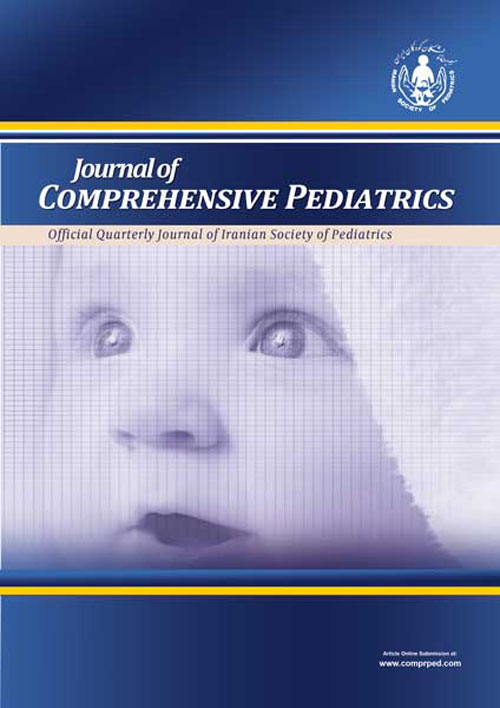فهرست مطالب

Journal of Comprehensive Pediatrics
Volume:7 Issue: 1, Feb 2016
- تاریخ انتشار: 1394/12/25
- تعداد عناوین: 5
-
-
Page 1BackgroundSepsis refers to an illness resulting from a systemic inflammatory response to infection, mainly caused by bacterial agents. Any delay in sepsis treatment can lead to high morbidity and mortality..ObjectivesThe aims of this study were to identify the common bacterial agents responsible for pediatric septicemia and determine their antimicrobial susceptibility patterns in Nemazee Hospital, Shiraz, Iran..
Patients andMethodsThis cross-sectional study was conducted within a two year period (2011 - 2013) for all patients with clinical manifestations of septicemia. Blood specimens were collected aseptically in BACTECTM blood bottles, and conventional bacteriological methods were followed for isolation and identification of the bacteria. Antimicrobial susceptibility tests were performed by using the disk diffusion method in accordance with CLSI recommendations..ResultsFrom a total of 491 blood cultures, 74 (15.1%) samples were detected as positive. The most common isolates were Gram positive cocci, and Staphylococcus epidermidis (48.6%) was found to be the most common Gram positive cocci. Among recovered Gram negative isolates, Acinetobacter spp. (8.1%) were the predominant isolates. Overall, the most effective antibiotics against Gram positive cocci were vancomycin (98%) and chloramphenicol (72.5%). In addition, the highest sensitivities to the agents tested against Gram negative isolates were to ciprofloxacin (47.8%) and chloramphenicol (30.4%)..ConclusionsDue to the variable nature of antibiotic susceptibility patterns and etiological agents of septicemia, continual assessment of the most frequent pathogens associated with bloodstream infections and detection of their sensitivity patterns to locally available antibiotics seem to be reasonable measures..Keywords: Sepsis, Microbial Sensitivity Tests, Anti, Bacterial Agents, Child, Hospitalized -
Page 2IntroductionThe use of an umbilical catheterization is a usual practice in neonatal units. The insertion of the catheter has potential complications..Case PresentationHere, we report on our observation of a seven-day-old female newborn admitted for an abdominal distention and vomiting bile. Initially, diagnosis was midgut volvulus, for which an operation was performed. During the surgery, no intestinal malrotation, mesenteric defect or atresia was observed. Postoperative diagnosis was abdominal wall hematoma and rand ligament and ileus, as well as, sub-capsular liver hematoma. The patient had been hospitalized at birth at a neonatal intensive care unit (NICU). With the appearance of icterus on the first day of life, at the NICU tried to insert the umbilical catheter that had been filed..ConclusionsThe complication found in the patient was the result of an aggressive act (the umbilical catheter insertion). This intervention should not be carried out unless there are clear indications, and if so, it should be done with much care..Keywords: Liver, Hematoma, Midgut, Volvulus, Medical Error, NICU
-
Page 3IntroductionRetention of a guidewire is one of the rare but potentially serious complications of central venous catheterization (CVC)..Case PresentationAn 11-year-old male presents with inadvertent retention of guidewire during CVC..ConclusionsThe management was successful and this is an avoidable complication and several precautions are explained to avoid this..Keywords: Central Venous Catheter, Guidewire, Retention, Children
-
Page 4BackgroundConsidering that enuresis is a common health problem among Iranian children, identifying the frequency of enuresis among children with adenoid hypertrophy (AH) and its related factors could help us design appropriate management plans as well as preventative and interventional studies..ObjectivesWe aimed to evaluate the prevalence of enuresis among children with AH and its associations with different characteristics of the disease..
Patients andMethodsThis study was designed as a cross-sectional study. Children aged 5 - 12 years diagnosed with adenoid hypertrophy and as well as a group of normal children were studied (2010 - 2011 in Shariati hospital). The prevalence of enuresis was determined and compared in the two groups. The frequencies of different symptoms related to AH were compared in AH patients with and without enuresis..ResultsDuring this study, children with (n = 60) and without (n = 60) adenoid hypertrophy were investigated. The prevalence of enuresis was significantly higher in patients with AH compared with the control group (40% vs. 15%, P = 0.004, OR = 8.19). Enuresis was more prevalent among patients with AH who had a severe form of the disease, the signs of which are obstructive sleep apnea (OSA), growth impairment, and irritability (PConclusionsThe results of our study indicated that enuresis was a common health problem among children with AH and it is associated with some symptoms of AH such as OSA, growth retardation and irritability. Using these findings as baseline data, we could determine the appropriate treatment approach for improving the course of the disease as well as the quality of the affected patients lives..Keywords: Adenoid Hypertrophy, Enuresis, Children -
Page 5IntroductionBrugada syndrome (BrS) is an autosomal-dominant inherited cardiac arrhythmia that occurs due to sodium channelopathy and increases sudden cardiac death due to episodes of polymorphic ventricular tachyarrhythmia. It is characterized by ST-segment elevation in the right precordial leads and right bundle branch block (RBBB) pattern. We herewith present a case of Brugada syndrome with an unusual presentation..Case PresentationA 2.5-year-old girl with a history of quadriplegic cerebral palsy was admitted due to aspiration pneumonia. Cardiovascular examination and echocardiography was normal. She had a history of surgery for gastro esophageal reflux disease and was under treatment with pantoprazole. Electrocardiogram revealed ST-segment elevation in the right precordial leads (V1 - V3). The patient died during hospitalization due to cardiac arrest before any intervention..ConclusionsThe most important feature of Brugada syndrome is clinically suspicion. Therefore it should be considered in cases with uncontrolled seizures, stroke, refractory seizures, recurrent syncope, repeated attacks VT and conduct disorders like RBBB in the absence of structural cardiac and metabolic disorders..Keywords: Brugada Syndrome, Fever, Pediatric, Sudden Cardiac Death, Ventricular Arrhythmia

